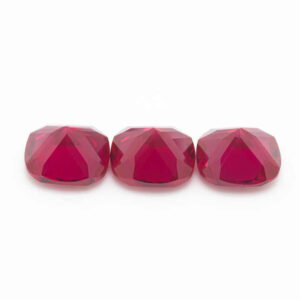Rubies have long been treasured for their deep red color, brilliance, and rarity. However, the rise of synthetic rubies — lab-created stones with identical chemical and physical properties — has made it more challenging to distinguish natural gems from their synthetic counterparts. In this article, we will explore two essential aspects:
- How to identify a synthetic ruby using scientific, lab-based methods.
- How to spot a synthetic ruby with practical techniques anyone can use.
Understanding Synthetic Rubies
Synthetic rubies are man-made gems created in controlled laboratory environments. They share the same chemical composition (Al₂O₃ with chromium for red color) as natural rubies but can often be produced with fewer inclusions and at a much lower cost.
1. How to Identify a Synthetic Ruby (Professional Laboratory Methods)
Jewelry professionals and gemologists rely on advanced techniques to determine whether a ruby is natural or synthetic. Here are some of the most reliable methods:
1.1 Microscopic Inclusion Analysis
Under a gemological microscope, natural rubies often display:
- Silk-like rutile inclusions
- Fingerprint inclusions
- Irregular growth lines
In contrast, synthetic rubies (especially flame-fusion types) frequently exhibit:
- Curved striae (growth lines)
- Gas bubbles
- Absence of natural inclusions
1.2 UV Fluorescence
Synthetic rubies often fluoresce strongly under UV light, especially those made by flame fusion. Natural rubies may also fluoresce, but not as uniformly or brightly.
1.3 Spectroscopy
Using a spectroscope, professionals can identify subtle differences in how rubies absorb light. Lab-created rubies can show slightly different chromium absorption lines.
1.4 Raman and FTIR Spectroscopy
Advanced laboratories use these tools to examine atomic-level vibrations. These methods can detect the minute structural differences between synthetic and natural rubies.
1.5 Refractive Index & Specific Gravity
While both types of rubies share similar optical properties, when combined with inclusion analysis, these metrics can help confirm the ruby’s origin.
2. How to Spot a Synthetic Ruby (DIY Tips for Consumers)
If you’re buying a ruby or evaluating one at home, here are some practical ways to spot a synthetic ruby without special tools:
2.1 Price Check
Natural rubies, especially those with high clarity and strong color, are expensive. A seemingly flawless ruby offered at a low price is likely synthetic or treated.
2.2 Inspect for Perfection
Natural stones usually contain minor inclusions or imperfections. If a ruby looks flawless, it may be synthetic.
2.3 Look for Bubbles and Curved Striae
Use a jeweler’s loupe (10x magnification) to look inside the gem. Gas bubbles and curved growth lines are typical indicators of synthetic rubies made via flame fusion.
2.4 Ask for Certification
Always request a certificate from a reputable gemological lab like GIA, IGI, or AGL. The certificate will clearly state whether the ruby is natural or lab-created.
2.5 Check for UV Reaction (Optional)
If you have access to a UV light source, observe the ruby’s reaction. A strong, uniform glow can suggest a synthetic origin.
3. Summary: Natural vs Synthetic Ruby – Key Differences
| Feature | Natural Ruby | Synthetic Ruby |
|---|---|---|
| Origin | Formed naturally over millions of years | Created in a laboratory |
| Inclusions | Natural silk, fingerprints | Gas bubbles, curved striae |
| UV Fluorescence | Weak to moderate | Bright and strong |
| Value | High | Lower |
| Cost | Expensive | Affordable |
Conclusion
Understanding the difference between natural and synthetic rubies is essential whether you’re a gem enthusiast, collector, or buyer. While professional identification requires lab tests and equipment, knowing how to spot a synthetic ruby using practical clues can save you from making costly mistakes. When in doubt, always consult a certified gemologist and insist on documentation. Knowledge is your best protection in the world of fine gems.







